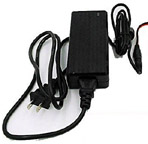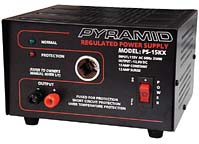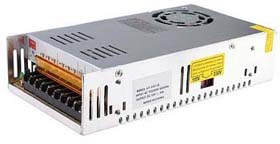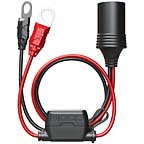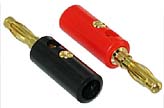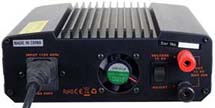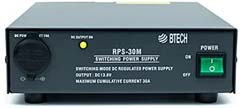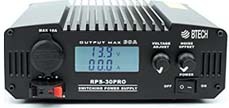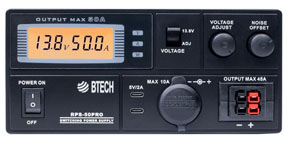Ham Radio - Camera -
Computer - F8HP - UV5R - Baofeng - Pofung
Power Supplies 1.01
13.8 VDC Power Supplies
Top to Bottom
by: John 'Miklor' K3NXU


Power Supplies 1.01
13.8 VDC Power Supplies
Top to Bottom
by: John 'Miklor' K3NXU

|
With more Dual Band and now Tri-Band radios being introduced into the ham
market, the question that comes up frequently is what type of supply is needed
to run the radio at home.
Rather than this being a review of a particular Power Supply, this is more a comparison between various types and models available to assist in making the proper purchasing decision. I am not going into the electronics inside the box, only what to expect and the options available. Linear Power Supplies Linear supplies have been around since the beginning of time. They are much heavier than switchers as they use large transformers to convert the AC input voltage to the proper lower voltage needed. The resulting output is then processed through a series of rectifiers and filters, resulting in a very clean, pure, ripple free output. These supplies are primarily used in audio amplifiers, PA systems, test equipment and any device requiring a pure, low noise power source. Because of their size and weight, these supplies can be a bit cumbersome. Switching Power Supplies Switching supplies came on the scene about four decades ago and are by far the most popular supplies used today, as the noise generated by these supplies can now be held to a minimum. One of the most common uses for switching style supplies is powering computer hardware. In comparison, a typical 5 amp Linear supply could easily weigh in at 5 pounds because of the transformers, where a 25-30 amp switching supply weighs in at about the same. Another advantage of switching power supplies is that they run much cooler. Ham Radio Applications At one time, using a switching supply for ham radio use was considered unacceptable due to the high and low frequency noise generated. However, today's newer supplies keep this noise to a minimum. Many include an option referred to as a Noise Offset. If noise is detected on a specific frequency, it can be manually shifted up or down.. With many new mobile transceivers used at home, these power supplies are becoming more popular than ever. While the average 25W transceiver will draw between 4-5A, a 50W transmitter will consume between 8-12A. Well within the capability of a 30A switcher. Current Ratings It is important to note that a supply rated 30A on surge may actually only produce only 25A in a continuous duty application. For FM transceiver applications, always refer to the continuous duty rating. Mini-Power Supplies There are small switching supplies available that I hesitate to recommend for transceiver operation. These supplies resemble laptop chargers, and are normally rated 12.6VDC at 3A Max. I use one with my Leixen VV898, a 10W transceiver that draws just over 1A on transmit. For a low power application, it works extremely well. However, I've tried this with a 25W transceiver and as expected, it produced about 11W max. Even if advertised as compatible with your transceiver, check the power rating. A 25W transmitter requires 13.6VDC at 3-4A minimum. My recommendation is unless you are running less than 10W, invest your money is a better supply.
Mid-Power Linear Supply The next example is a linear style supply. The one shown here is a Pyramid PS15KX, but don't let the model number fool you. The reviews are excellent, but it is not a 15A power supply as you might assume by the name. It's actually rated 10A Continuous. The nice thing about Pyramid supplies is that they are solidly built. Typical of a linear supply, as mentioned above, it is a 10A supply and weighs just over 10 pounds. If your radio uses the vehicle's accessory jack, you can easily run it with this supply. Even though it shows both accessory plug and terminals, the maximum output combines is 10A Maximum. That's enough to power the average 25W mobile, but a 50W mobile would push it over the limit.
Basic 30A Switching Supply If you are on a tight budget, this may be a potential solution. A simple bare bones 30A switching supply can be purchased for around $25. Most have the option of either 110VAC or 220VAC input. The example below shows a chassis with 8 terminals. - Two for the 110/220VAC input - Three for the 12VDC positive output - Three for the 12VDC negative output. These are exposed terminals, so caution as well as proper fusing must be used. To power a small mobile transceiver, you may also need to purchase a 12VDC accessory plug. They are very basic with no frills, but can get the job done.
Full Function Switching Power Supply The other option is to acquire a complete full function power supply (shown below). The examples here show the various options which are available. Although similar in appearance, the configurations are very different. Here are some of the options available. 30A main terminals - This if where the rubber meets the road. Note that all variations below show 30 Amp in some capacity, either as Continuous or Surge. For FM transceiver operation, I would concentrate on the Continuous rating. The screw terminals on the supply accept either stranded wire or traditional banana jacks.
10A accessory plug - Most 25W transceivers provide a 12V power plug for your vehicles accessory jack. This jack is normally fused for around 10A. Having an accessory jack on the face of the power supply makes it convenient to swap your radio from the car to the house. 3-5A front terminals - A pair of auxiliary terminals on the front can be used for that second radio running 25W or less. 5V 2A USB Output - If you want the convenience of charging you mobile devices, some come equipped with USB-C jacks. Voltage Output - The supplies below give you the flexibility of of either fixed 13.8V, or variable 9-15VDC. This is selectable by a switch on the back. Noise Offset - As well filtered and regulated as they are, there's always the possibility of noise spike showing up. The newer supplies offer a noise adjust which allows the user to shift this noise to a different frequency if this should occur. Anderson Powerpole - Becoming more of an Amateur Radio standard standard for radios to DC power sources. Below is an example of three power supplies.
|
||||||||||||||||||||||
